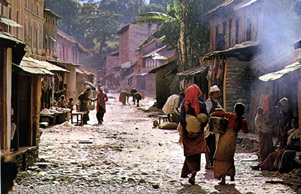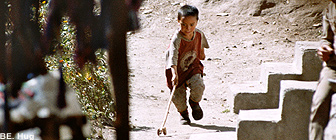|
Slavery
and Freedom in Nepal |
 |
Nepal Social Life - Minorities |
|
 |
| The
Kamaiyas- Former bonded labourer |
| Who
are the Kamaiyas? |
 |
The
term "Kamaiya" means bonded labourer. Literally being bonded to a landlord
due to the inability to pay off a debt.
An
estimated 93% of the Kamaiyas belong to the indigenous Tharu community
of the south-west region of the Terai (lowlands). Even today, Tharu people
live in a mainly cash-less society. What land they may own is in constant
use growing staple foodstuffs such as rice, mustard oil and lentils to
meet the families needs. Few men have the time or ability to work outside
the family home and what little cash they do have goes on other basic necessities
such as kerosene for light, clothing and festival expenses. For larger
purchases, such as a new buffalo to pull the cart, wedding expenses etc
there is very often no other recourse but to borrow money.
Kamaiyas
lived as feudal serfs with whole families live on a landlord's estate,
providing labour in return for the very basic necessities of life - a roof
over their head and the minimum of food. Often the debt due to the landlord
was incurred one or more generation before and usually consists of a relatively
small amount. With a system of interest and the non-access to cash - 96%
of all Kamaiyas are illiterate and 98% are landless - the Kamaiyas face
a continual circle of being bound to the landlord for life with their children
being born into this modern day slavery.
Life
was a constant struggle of labouring for an often harsh landlord and trying
to supplement their basic needs. Many Kamaiyas know of no other way of
life and despite the fact that the Kamaiya System Liberation (KPUS) was
established in 1997, most were unprepared for the event that took place
on 17 July 2000.
Land
in Nepal is scarce. And, when it comes to fertile agricultural land, it
is far scarcer. Scarcity breeds competition; and competition in turn opens
up possibilities for deceit and the use of unfair means. These phenomenon
pervade the history of land ownership in Nepal. Scarcity, competition and
inequality characterize land distribution in the country today.
The
Kamaiya system that was prevalent in the five districts of western Nepal-before
being finally banned by the government on July 17, 2000-was one of the
unpleasant by-products of Nepal's checkered history of land ownership.
The Tharus are indigenous to the Terai. They were the natural owners of
these vast tracts of fertile land.
top
| Facts
about Kamaiyas |
 |
 |
16%
of Kamaiyas are under 20 years of age |
 |
76%
of Kamaiyas are under 40 years of age |
 |
Average
Kamaiya family size is 6.3 members |
 |
73%
of Kamaiyas do not have their own house |
 |
Kamaiyas
yearly minimum expenses are Rs. 3,894 for wedding ceremonies, Rs. 415 for
birth rituals, Rs. 1,851 for death rituals and for festival and clothing
Rs. 5,365 (US$ 1= NRs. 75) |
 |
Kamaiya
families face serious food deficits in order to feed the family yearly
(an average of 433kg of rice is required per annum) |
 |
96%
of all Kamaiyas are illiterate |
Source:
INSEC |
 |
|
Information |
 |
top
|
Links
|
 |
 |
 |
External
Links |
|




